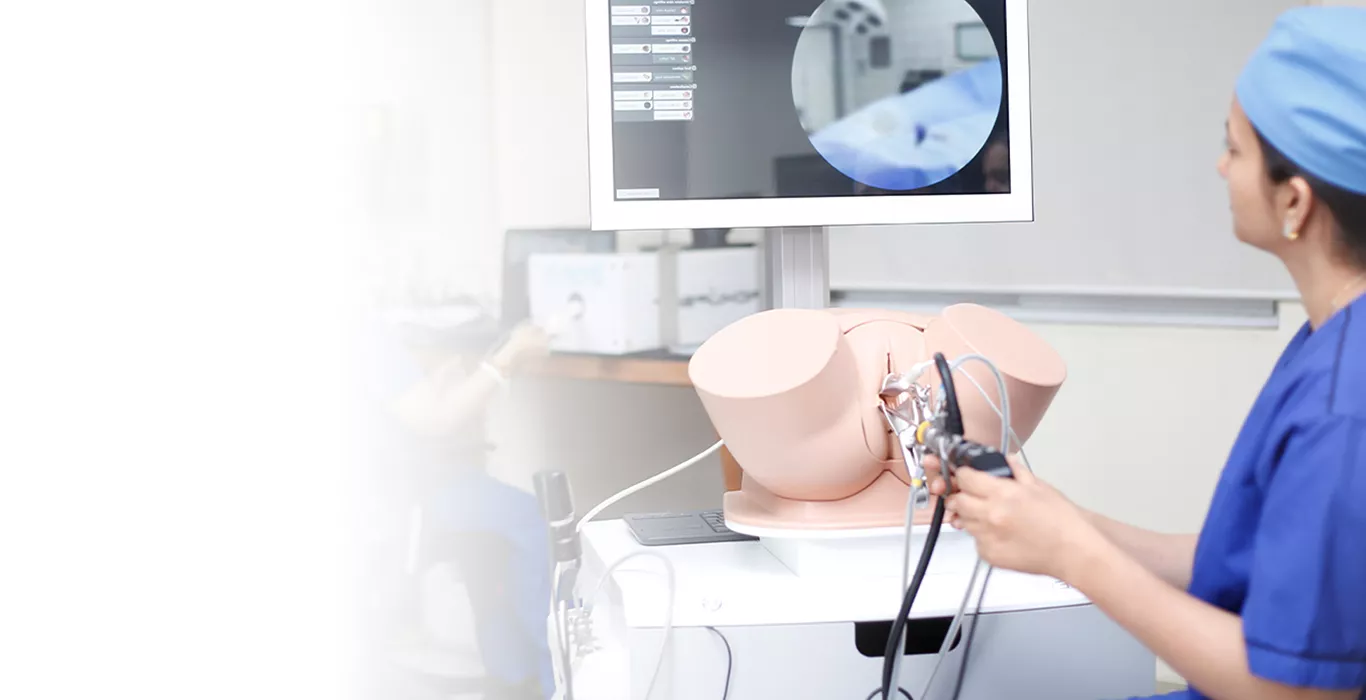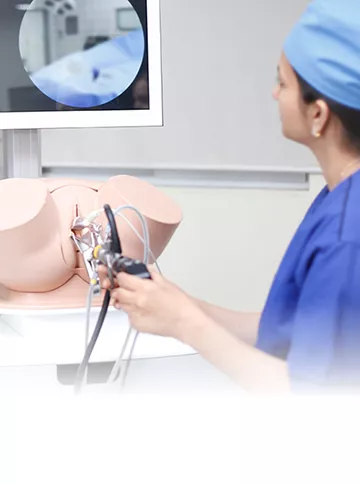What is a Hysteroscopy?
With advancements in medical science, several minimally invasive and safe techniques have evolved, allowing doctors to perform diagnostic and operative procedures with minimal risk. For women going through fertility problems, the procedures like hysteroscopy can help doctors look inside the woman’s uterus and other organs without making large incisions. Here is a detailed understanding of hysteroscopy.
Hysteroscopy is a minimally invasive medical procedure that allows doctors to look inside the uterus, diagnose, and treat issues like endometrial lining abnormality, abnormal bleeding, fibroids, uterine polyps, etc.
The procedure uses a device called a hysteroscope. A hysteroscope is a thin, flexible instrument that has a camera and a light source attached to one end. A hysteroscope is inserted through the cervix and into the uterus. The uterus is then expanded with a fluid or gas to enhance visibility, allowing the surgeon to examine the uterine lining, detect any abnormalities, and perform the required surgical procedures.
Types of Hysteroscopy
In general, hysteroscopy procedures are of two types:
1. Diagnostic hysteroscopy
Women who are going through issues like abnormal bleeding may be subjected to hysteroscopy to look for the cause of the problem. The procedure may also be used with other diagnostic tests like ultrasound or hysterosalpingography to confirm certain diagnoses. Conditions that can be diagnosed using a Hysteroscopy include abnormal uterine bleeding, Uterine Fibroids, Uterine Polyps, Adhesions, Endometrial Cancer, etc.
2. Operative hysteroscopy
In this type of hysteroscopic procedure, minor surgical interventions are performed. This type of hysteroscopy can be done in conjunction with diagnostic hysteroscopy to treat the underlying issues. Operative hysteroscopy can be used to perform procedures like Hysteroscopic Polypectomy, Endometrial Ablation, Myomectomy, Septoplasty, Adhesiolysis, etc.
Why Hysteroscopy?
As mentioned earlier, hysteroscopy can be used to diagnose or treat several conditions. Common hysteroscopy uses include:
- Diagnosing Uterine Abnormalities
- Treatment of Uterine Abnormalities
- Evaluation of Infertility
- Treatment of Abnormal Uterine Bleeding
- Diagnosis of Endometrial Cancer
- Performing procedures like Hysteroscopy Polypectomy, Septoplasty, etc.
Preparing for a Hysteroscopy
A hysteroscopy is usually an outpatient procedure, and the patient will be discharged and can go home the same day. Let’s see the procedure involved.
Doctors will perform a physical exam and go over your symptoms to determine if you are a candidate for a hysteroscopy. Pregnant women or women with pelvic infections would usually not be recommended for a hysteroscopy.
To prepare for a Hysteroscopy, follow these general guidelines:
- Ask the doctor any queries you may have regarding the procedure.
- Inform the doctor about any medicines or supplements you are currently taking.
- Avoid sexual activity to reduce the risk of infection.
- Follow fasting instructions as provided by your doctor.
- Arrange for someone to drive you to your appointment and back.
- Wear comfortable clothing.
What to expect during a Hysteroscopy?
Here is how a hysteroscopy is performed and what you can expect during it:
- For the hysteroscopy procedure, you will be asked to empty your bladder & change into a hospital gown.
- You may receive anaesthesia or a sedative to help you relax, depending on the location of the procedure and whether other procedures are scheduled to take place simultaneously with the hysteroscopy.
- You will be positioned on an exam table with your legs in stirrups.
- The surgeon will perform a pelvic exam and dilate your cervix to allow the insertion of the hysteroscope.
- The hysteroscope will be inserted through your vagina and cervix into your uterus.
- A liquid solution will be sent through the hysteroscope to gently expand and clear any blood or mucus from your uterus, allowing for better visibility.
- The surgeon will inspect your uterine cavity and the openings of your fallopian tubes using the light from the hysteroscope.
- Surgical instruments may be inserted through the hysteroscope to remove any abnormalities if surgery is necessary.
- The length of the hysteroscopy procedure can range from five minutes to over an hour, depending on whether it is diagnostic or operative and if any additional procedures are scheduled to take place. Diagnostic hysteroscopy typically takes less time than operative hysteroscopy.
After a Hysteroscopy
Once hysteroscopy is performed, you will be observed in the recovery room for some hours if you were given anaesthesia.
- Patients are usually discharged on the same day after the procedure. In some cases, an overnight stay may be required.
- You may experience mild cramping, unusual bleeding, or spotting for a few days.
- You may be instructed to avoid sexual intercourse and use tampons for at least a week after the procedure to reduce the possible infection.
- Your doctor may prescribe pain medication if you experience discomfort, and you should contact them if you experience any severe pain, fever, or heavy bleeding after the procedure.
- The results of the hysteroscopy will be shared with you by your doctor after the procedure, and they will discuss any findings or necessary follow-up treatment with you. Depending on the results, your doctor may recommend further testing, additional procedures, or other treatments.
- It is important to rest and avoid strenuous activity for a few days after the procedure and to follow all post-operative instructions provided by your doctor to ensure a smooth recovery.
Benefits of Hysteroscopy
Hysteroscopy has several advantages:
- Simultaneously perform diagnostic and operative procedures with minimally invasive technique
- Precise surgical intervention
- Lesser risk of complications
- Lesser trauma and pain
- Quicker recovery
- Shorter hospital stay
Hysteroscopy for IVF
Among other uses of hysteroscopy, IVF optimization is an important one. For the success of IVF, there must be no factors that may interfere with the successful implantation of the embryo. Here are a few ways in which, with the use of hysteroscopy IVF, success possibility of getting pregnant can improve:
- To look for abnormalities in the uterine cavity, such as polyps, fibroids, or adhesions, that can interfere with implantation and reduce the success rate of IVF.
- To check the position of the embryos and the uterine lining and ensure optimal conditions for implantation and improve the chances of IVF success.
Hysteroscopy Complications
Although hysteroscopy is a minimally invasive procedure with very few complications, these may occur just like with any medical procedure. A few complications that may be associated with hysteroscopy include:
- Fever
- Fluid overload
- Heavy bleeding
- Infection
- Intrauterine scarring
- Perforation
- Reaction to the anaesthesia or to the substance used to expand the uterus during the procedure
- Reaction to the substance used to expand your uterus
- Trauma to the cervix, uterus, bowel or bladder
Any worrying symptoms after a hysteroscopy must be informed to the doctor immediately. It is also important to ensure that you consult only the qualified and experienced doctors.
Pregnancy Calculator Tools for Confident and Stress-Free Pregnancy Planning
Get quick understanding of your fertility cycle and accordingly make a schedule to track it
Get a free consultation!















